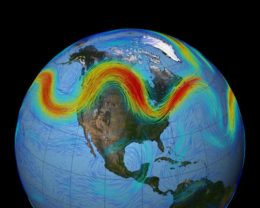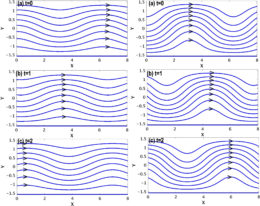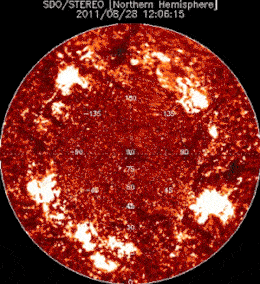Sinuous, undulating waves in the Earth’s atmosphere play a large role in driving the weather patterns on our planet. A new study now describes how similar motion can govern the behavior of the Sun — and what we stand to learn from it.
Seeing the Future

Visualization of Rossby waves in the Earth’s northern hemisphere jet stream. See the end of the article for a video. [NASA/Goddard Space Flight Center Scientific Visualization Studio]
In 1939, Rossby first identified large-scale waves in the Earth’s atmosphere. These slow meanders of high-altitude winds are visible as long, persistent undulations in the jet stream that carry cells of warmer or cooler air to different regions of the planet.
Through this transport, Rossby waves are critical in driving the day-to-day weather patterns that we experience at middle and higher latitudes on our planet’s surface. Our understanding of the hydrodynamics of Rossby waves is, consequently, one of the things that enables us to make (approximate) weather predictions on timescales of roughly 14 days.
Waves Far and Wide
But Rossby waves aren’t specific to Earth’s atmosphere; they can arise naturally within any fluids that exhibit differential rotation. Scientists have studied some cases of Rossby waves in detail — like those in the Earth’s oceans, or in Jupiter’s atmosphere. But less is known about the role of Rossby waves on an even larger rotating body: the Sun.
Are the motions of the Sun’s atmosphere governed by these same waves? And if so, can we figure out how to model them similarly to how we model Rossby waves on Earth, thereby unlocking a key to making solar weather predictions on 14-rotation (that’s around a year, given the Sun’s rotation period!) timescales?
But What About Magnetic Fields?
The answer to the first question is yes: signs of Rossby waves have already been observed on the Sun, in the form of persistent, global velocity patterns that evolve on timescales longer than a solar rotation period, but shorter than a solar cycle.
The answer to the second question, however, is less clear. Why? Because there’s a complicating factor: unlike Earth’s lower atmosphere, the Sun is strongly magnetized. A new study led by Mausumi Dikpati (National Center for Atmospheric Research) now walks us through the basic physics involved in Rossby wave development in the Sun, and discusses how the Sun’s magnetic fields influence those waves.
Sketching a Wavy Picture

The propagation of the two classes of magnetic Rossby waves: retrograde waves (left) and prograde waves (right). [Dikpati et al. 2020]
The basic physics described here is a first step that now needs to be expanded to include more complex interactions. But this starting point demonstrates that Rossby waves likely play an important role in organizing the motions of the Sun’s atmosphere. And once we’ve developed more detailed models of this process, perhaps we’ll be able to check our phones for the solar weather forecast for the year!
Bonus
Check out this wildly awesome NASA-produced simulation showing the development of Rossby waves in the Earth’s northern jet stream.
Citation
“Physics of Magnetohydrodynamic Rossby Waves in the Sun,” Mausumi Dikpati et al 2020 ApJ 896 141. doi:10.3847/1538-4357/ab8b63

